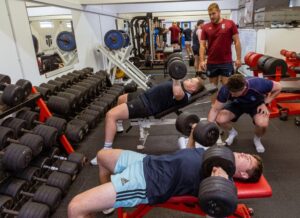A lot of people in the rugby community seem to be scared of using plyometrics. They sight that it is dangerous to use with larger players, or that they have used them and had an injury spike afterwards. The question is, how have they programmed them and have they built up slowly to the more advanced plyos? I think there is also a little misunderstanding and confusion about what plyometrics actually are. This article should help clarify it for you, so you can use plyometrics safely and effectively…
What Does The Research Say?
Plyometrics are often discussed as a power and speed training technique. But that’s not all they can improve. Research suggests that athletes with better plyometric ability are not only faster and more powerful, but are fitter and less prone to injury. How??.. Through energy efficiency!
Plyometric ability involves utilising stored elastic energy with every foot strike and not relying heavily on the musculature. Consider how many foot strikes occur in a game and you can see that there is a lot of energy saved. If you don’t stress the muscles as much and you reduce fatigue, you then decrease injury risk… You can now appreciate why you should be using plyometrics!
What are Plyometrics?
Plyometrics are any exercises that involve a stretch-shortening cycle (SSC). The SSC is where you muscles move from an eccentric action (lengthening), immediately into a concentric action (shortening). There are two types of SSC which we are interested in; fast <250ms ground contact time and slow >250ms ground contact time.
Both fast and slow plyometrics correlate well with performance. The literature is still a bit fuzzy, but generally speaking slow plyometrics are related to acceleration and fast plyometrics relate to speed. Knowing your ability in both fast and slow plyometrics can help you program and improve your weakness.
Plyometrics For Rugby – The Truth!
Testing Your Plyometric Ability
The easy way is to use a jump mat, but obviously not everyone has access to one. You can however easily test you counter-movement jump using a piece of chalk and a wall!
For your slow SSC ability you will test your vertical jump. A good goal for a forward is to get over 26 inches, and over 30 inches for a back. If you can’t hit these targets you should emphasise slow plyos in your training initially.
Now to test your fast SSC ability you need to perform a depth jump where you step off a box (60cm high) land and jump as quickly as possible into a vertical jump (remember fast SSC is about quick ground contact time). Verkhoshansky found that an athlete with a good SSC could perform 10% better in a 60cm depth jump than a standard vertical jump. If you perform worse or less than 10% better you will benefit from training your fast SSC.
*Most backs can get away with using this test straight away but some players (especially big forwards) may need to practice some low level training progressions before being comfortable testing like this.
Plyometrics Training
Early Stages
For some athletes plyometric ability comes naturally and they can progress quickly to fast SSC training. For most it is wise to progress slowly and begin with basic movements that will teach the athlete the fundamentals. Important cues to ingrain early are to spend minimal time on the floor, put load through the ball of the foot (not the heel or flat footed), and develop stiffness.
Great exercises include:
- Skipping
- Ankling
- Pogo Hops
- Low Level Bounds (sticking the landing)
- Depth Landings (step off a low box, stick landing)
Things to avoid include knees coming in on landing, losing stiffness, long ground contact time etc. Only progress once athlete is proficient.
Rugby Plyometrics: Single Leg Plyometric Progressions
Slow SSC Plyometrics
These exercises can be utilised whilst still learning technique of the fast SSC exercises and can help develop the power needed for acceleration.
Great exercises include:
- Vertical Jump
- Box Jumps
- Seated Box Jumps
- Knees to Feet
- Broad Jumps
- Banded Broad Jumps
Box Jumps are a great beginner exercise for larger players as they reduce the eccentric stress on the joints as the landing impact is reduced.
Fast SSC Plyometrics
Once you have developed the skills with the introductory exercises, built your explosive power and increased your vertical jump… it is then time to polish your performance with fast SSC exercises. Remember we are looking for minimal ground contact time and maximum speed!!
Here are some great variations to try:
- Depth Jumps (progress height slowly)
- Depth Jump into Box Jump
- Bounds
- Hurdle Bounds
Only increase the height of the boxes or hurdles of the athlete can maintain speed and minimal ground contact time. If they get slower you aren’t training what you are trying to.
Loading
For the low level introductory exercises you can use higher reps but once you get into actually training the SSC, stick to 3-5 sets of 3-5 reps to start. Over time you can increase to 8-10 reps per set but then stick to 3-4 sets only.
Rest periods should be long to allow full recovery (2-3mins) and ensure that performance is quick and explosive.
You shouldn’t be training plyometrics hard all year round, they are very demanding on the nervous system and will leave you fatigued. They should be part of your periodised plan and focused on 3-4 times per season. Low level exercises could and should be practised at other times of year though.
Complex Training
Complex training involves alternating a plyometric exercise with a strength exercise. The result is the heavy load excites the nervous system and increases performance on the plyometric exercise. Then the speed of the plyometric exercise also excites the nervous system, resulting in improved performance on the heavy exercise. This phenomenon is known as post activation potentiation. Its a bit of a mouthful but it works! Heres an example:
Back Squat x3 reps @80-90% 1RM
2min Rest
Depth Jump x5 reps @45cm Box
2min Rest
Back Squat x3 reps @80-90% 1RM
and so on….
Conclusion
Hopefully you can see why plyometrics are important for improving rugby and athletic performance. There is much confusion out there, especially about their use with larger players. Not everyone will be able to perform high level exercises, but they should perform some plyometric training suitable to them. Other players may be surprised at how much they improve and what level they can achieve. Plyometrics can be demanding, but used correctly at the right times and in the right volume they can have a massive impact on performance.





